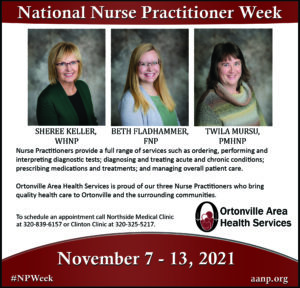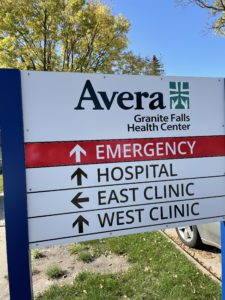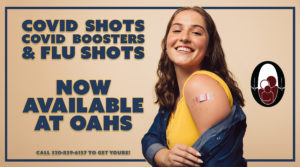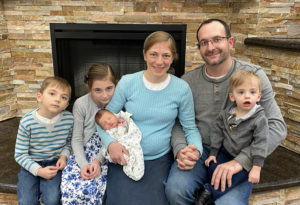In the Fall of 2020, monoclonal antibody therapy was approved by the FDA under the emergency use authorization for the treatment of COVID-19. Monoclonal antibody therapy introduces laboratory-produced molecules that act as substitute antibodies that can restore, enhance, or mimic the immune system’s attack on cells. Not long after the approval from the FDA, the leadership of Ortonville Area Health Services (OAHS) chose to offer the treatment in Ortonville, MN. “After looking at the data, we saw clear benefits,” explained Dr. Allan Ross, Chief Medical Officer at OAHS. “That led to us being one of the first facilities in the area to use monoclonal antibody therapy.” Dr. Ross continued, “I saw an article at the end of December of 2020 showing the number of infusions Massachusetts General Hospital (Harvard Medical School) had done. At that point, we had given more infusions at OAHS!”
Archives for 2021
Ortonville Area Health Services – Rural Health Leads the way with Monoclonal Antibody Therapy.
Monoclonal Antibody
COVID & Flu Shots Available!
Dr. David Collins Talks Covid on KDIO
OAHS Healthcare Board of Directors Welcomes Jane Vangsness Frisch, Ph.D.
 The Ortonville Area Health Services (OAHS) Healthcare board is happy to welcome Jane Vangsness Frisch, Ph.D. as the newest director.
The Ortonville Area Health Services (OAHS) Healthcare board is happy to welcome Jane Vangsness Frisch, Ph.D. as the newest director.
Vangsness Frisch lives in rural Dumont, Minnesota and is the Vice President for Student Affairs at North Dakota State College of Science in Wahpeton and Fargo, ND.
“OAHS has been an integral part of west-central Minnesota for many years,” said Vangsness Frisch. “I am honored to have the opportunity to support OAHS to ensure it thrives well into the future.”
Vangsness Frisch, originally from Okabena, MN., graduated from North Dakota State University with a bachelor’s degree in both mass communication with an emphasis in public relations and health education. Additionally, she earned a master’s degree in mass communication and a doctoral degree in institutional analysis. She previously worked for the North Dakota University System (Bismarck, ND) as the Director of Student Affairs.
Who’s Getting Vaccinated?
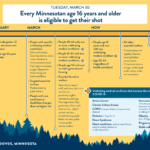 As of March 30, all Minnesotans 16 years of age and older will be eligible to receive a vaccine.
As of March 30, all Minnesotans 16 years of age and older will be eligible to receive a vaccine.
Minnesota has directed providers to prioritize vaccine appointments for people most at risk of getting COVID-19, or those who could develop severe illness if infected. This includes older Minnesotans, those with underlying health conditions*, and those in essential jobs.
How to get your vaccine:
- Sign up for the Minnesota COVID-19 Vaccine Connector. The Vaccine Connector will inform you about vaccine opportunities in your area.
- Use the Vaccine Locator Map to find vaccine providers near you.
- Contact your primary health care provider or a local pharmacy.
- Vaccine Connector users may also be randomly selected to make an appointment at one of the state’s COVID-19 Community Vaccination Program sites. If you are selected, you will be notified by text, email, or phone call by one of the state vaccination partners running those sites: Vault Health, Primary Bio or SpeciaLysts (Solv).
- Your employer may also reach out with information about vaccination opportunities.
Stay safe before your opportunity to get the vaccine:
While all Minnesotans 16 years and older are eligible, not every Minnesotan will be immediately able to make an appointment. It’s important to continue taking easy steps to slow the spread of COVID-19:
- Wear a mask
- Maintain physical distancing
- Wash your hands
- Get a COVID-19 test if you need one. Find a no-cost testing location near you or order an at-home test at no cost.
Get vaccinated at the first opportunity you have. After you have been vaccinated, continue following these safe practices to protect your neighbors as they receive their opportunity to get the vaccine.
At this time, providers should prioritize:
- Minnesotans 65 years of age or older
- Health care personnel
- Long-term care residents
- Pre-k to 12th grade educators and child care personnel
- People with specific underlying health conditions
- Sickle cell disease, Down Syndrome, or oxygen-dependent chronic lung or heart conditions, and those who are in active cancer treatment or immunocompromised from organ transplant
- Targeted essential workers
- Food processing plants
- People with rare conditions or disabilities that put them at higher risk
- People 45 years of age and older with ONE or more underlying medical conditions; or, age 16 and over with TWO or more underlying medical conditions*
- People 50 years of age or older in multi-generational housing
- Essential frontline workers
- Agricultural, airport staff, additional child care workers not previously eligible, correctional settings, first responders, food production, food retail, food service, judicial system workers, manufacturing, public health workers, public transit, Postal Service workers
- Minnesotans 16 years of age and older with any underlying medical condition*
- Minnesotans age 50-64 (regardless of health condition)
- All other essential workforces
- Transportation and logistics, finance, housing/shelter construction, IT/communications, energy, media, legal, public safety, water, and wastewater
https://mn.gov/covid19/vaccine/whos-getting-vaccinated/index.jsp
Vaccine Update
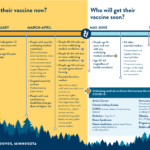 Who can get their vaccine now?
Who can get their vaccine now?
- Minnesotans aged 65 or older
- Health care workers and people working at health care facilities, first responders who provide direct patient care as part of the EMS system, and primary caregivers for people with complex medical needs or disabilities
- Long-term care residents and staff members at long-term care facilities in Minnesota
- Pre-kindergarten through Adult Basic and Community Education school staff members, or contracted school staff members, at schools in Minnesota
- Child care staff members at licensed and certified child care centers or programs in Minnesota
- People with specific underlying health conditions:
- Sickle cell disease, Down Syndrome, or oxygen-dependent chronic lung or heart conditions, and those who are in active cancer treatment or immunocompromised from organ transplant
- Targeted essential workers
- Food processing plants
- People with rare conditions or disabilities that put them at higher risk
- People age 45 and older with ONE or more underlying medical conditions; or, age 16 and over with TWO or more underlying medical conditions*
- People 50+ in multi-generational housing
- Essential frontline workers
- Agricultural, airport staff, additional child care workers not previously eligible, correctional settings, first responders, food production, food retail, food service, judicial system workers, manufacturing, public health workers, public transit, Postal Service workers
Who will get their vaccine soon?
May-June
- 16+ with any underlying medical condition*
- Age 50-64 (regardless of health condition)
- All other essential workforces
- Transportation and logistics, finance, housing/shelter construction, IT/communications, energy, media, legal, public safety, water, and wastewater
Summer
- General public
By this summer, every Minnesotan who wants a shot will be able to get one!
*Underlying Medical Conditions
- Active cancer
- Chronic kidney disease
- COPD (chronic obstructive pulmonary disease)
- Diabetes – Type 1 or 2
- Down Syndrome
- Heart conditions, such as heart failure, coronary artery disease, or cardiomyopathies
- Immunocompromised state (weakened immune system) from solid organ transplant, HIV, bone marrow disease, chronic steroids for more than 30 days, immunodeficiency disease, or taking immunosuppressive medications
- Obesity – body mass index (BMI) greater than 30 kg/m2
- Pregnancy
- Sickle cell disease
